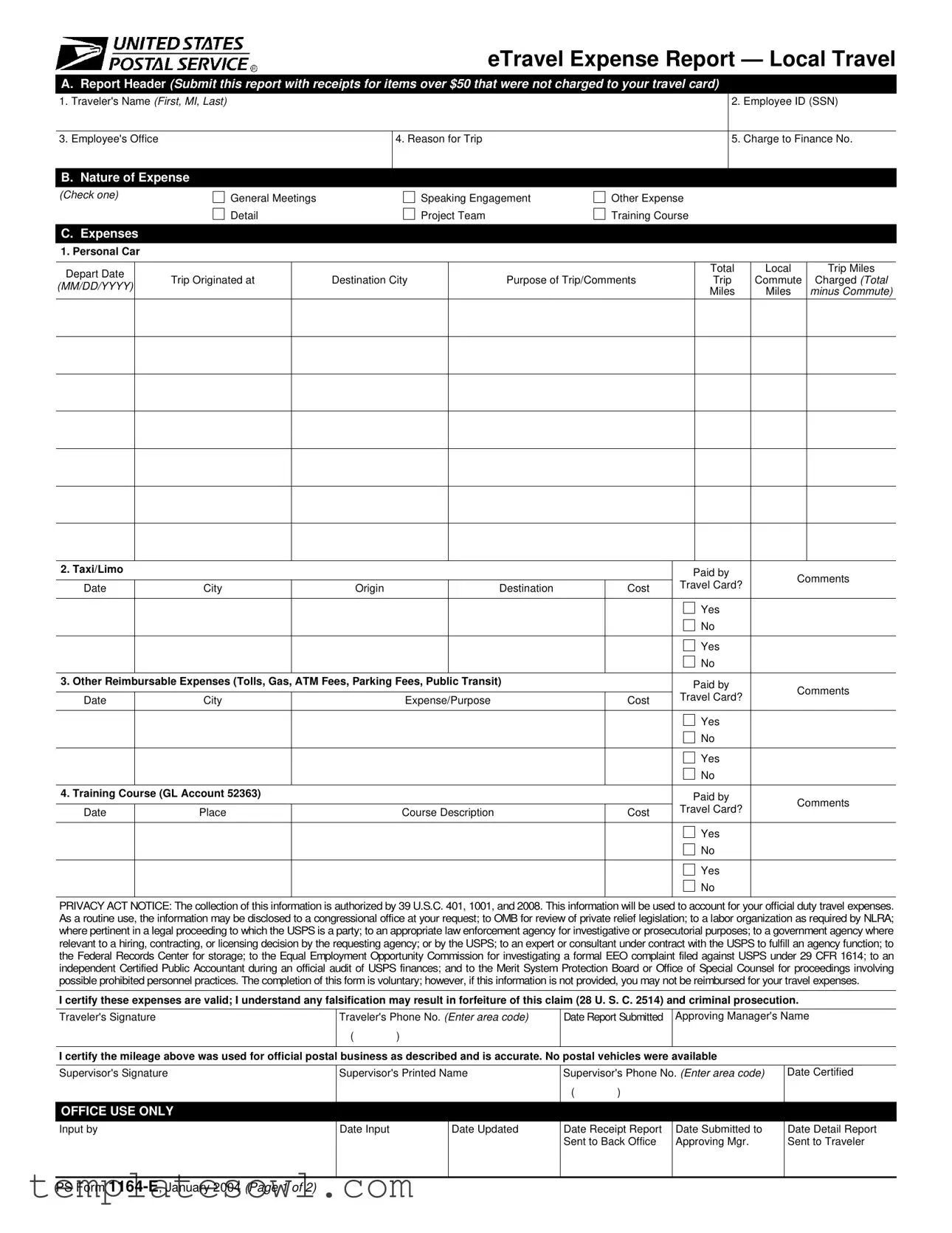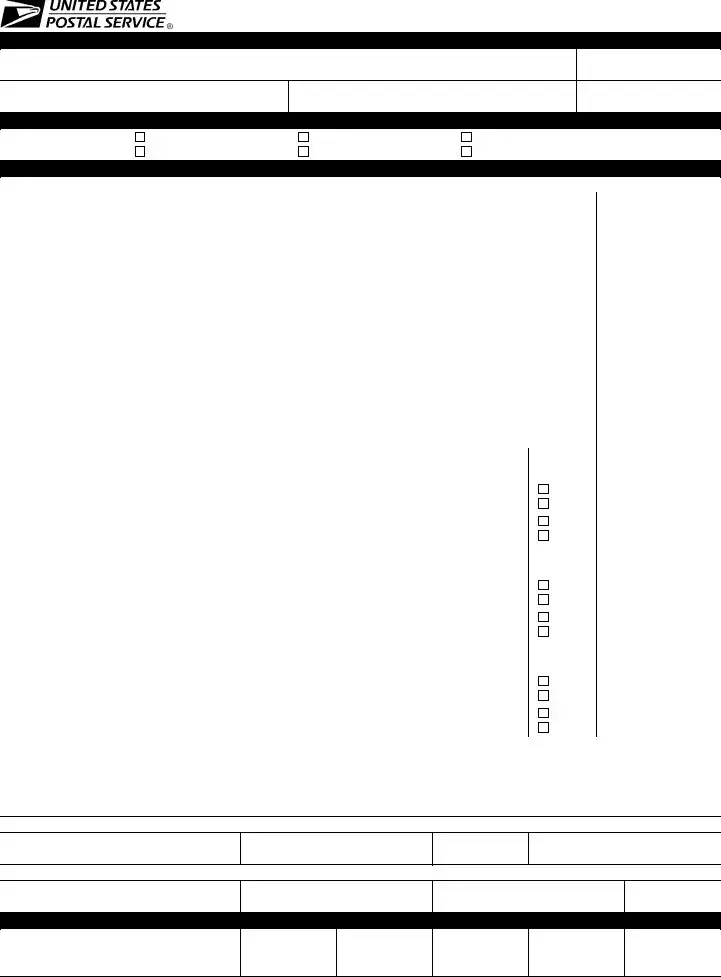A.Report Header
1.Traveler's Name: Print First Name, Middle Initial, and Last Name (to be used in naming convention for expense report).
2.Employee ID: Enter the traveler's Social Security Number.
3.Employee's Office: Enter the name of the Duty Station.
4.Reason for Trip: Briefly describe the reason(s) you traveled, e.g., POS One training, OIC assignment, MPOO meeting.
5.Charge to Finance No.: Enter the finance number to be charged.
B.Nature of Expense
Check one of the boxes listed. Note: Form 1164-E may be used for more than travel payments. You can also use eTravel for other approved reimbursements, such as training registration fees.
C.Expenses
1.Personal Car
a.Depart Date: Enter the first date of travel.
b.Trip Originated at: Enter the location where the trip in your personal car originated, e.g., residence or name of office.
c.Destination City: Enter the location where the trip in your personal car ended.
d.Purpose of the Trip/Comments: Enter the reason for travel and provide information for the approving manager of any special circumstances involved in driving your personal car.
e.Total Trip Miles: Enter the total miles driven to and from the destination.
f.Local Commute Miles: When the trip begins and ends at the traveler's residence, enter the round trip miles from the residence to the official duty station. When the trip begins and ends at the traveler's official duty station, enter zero.
g.Trip Miles Charged: Enter the total trip miles minus the local commute miles. This is your reimbursable miles.
2.Taxi/Limo
a.Date: Enter the date of your taxi/limo ride.
b.City: Enter the city where you rode the taxi/limo.
c.Origin: Enter the location where you were picked up, e.g., hotel, airport, residence, etc.
d.Destination: Enter the location where you were dropped off.
e.Cost: Enter the cost of the ride (may include a tip up to 15%).
f.Paid by Travel Card? Indicate if you paid for the taxi/limo with your government travel card by checking either "Yes" or "No".
g.Comments: List any comments about your taxi/limo expense, if necessary, such as sharing with other USPS employees, etc.
3.Other Reimbursable Expenses
a.Date: Enter the date the other expense occurred.
b.City: Enter the city where the expense occurred.
c.Expense/Purpose: Describe the expense you incurred. Some examples of expenses that should be entered here include tolls, cash advance fees (fees only, not the amount of the cash advance), gas, or parking.
d.Cost: Enter the cost of the expense.
e.Paid by Travel Card? Indicate if you paid for the other expense with your government travel card by checking either "Yes" or "No".
f.Comments: Enter any comments about the expense.
4.Training Course (GL Account 52363) — Tuition Only
a.Date: Enter start date of the course.
b.Place: Enter type of institution where training course was taken, e.g., Facility, University, Other).
c.Course Description: Enter the type of course taken.
d.Cost: Enter tuition paid.
e.Paid by Travel Card? Indicate if you paid for the training expense with your government travel card by checking either "Yes" or "No".
f.Comments: Enter any comments about the expense.
Note: The person entering the expense report must change the general ledger account in the GL Account field of eTravel to training expenses.
Traveler's Signature: The traveler's signature certifies factual presentation of all expense entries and compliance with USPS expense policy.
Phone No.: A phone number where the traveler can be reached if there are questions about your travel expenses.
Date Report Submitted: Enter the date the traveler sent the eTravel Expense Report to the employee for entry into eTravel.
Approving Manager's Name: Enter the name of the manager
to whom the travel report should be submitted. Note: This field must contain a manager's name, not a supervisor's name. Managers who can approve a travel report are defined in Handbook F-15, Travel and Relocation, Appendix C.
Supervisor's Signature: Supervisor is station manager or office postmaster. The supervisor's signature certifies that local travel was for official Postal Service ™ business and no Postal Service vehicles were available. In signature block include signature with printed name, phone number, and date certified.
Office Use Only
To be completed by the employee who enters the expense report data into the eTravel system on behalf of the traveler. Once the data is entered into the eTravel system, original form and backup are maintained in the office of the web alias. A copy of the eTravel Detailed Report is sent to the traveler. Any questions from the approving manager will be addressed to the traveler.
Additional Comments
Any questions concerning completion of this form or about travel, should be addressed through the district eTravel coordinator or the employee designated to enter PS Form 1164-E into eTravel through Web Alias.
After completing this form, forward the form and all receipts for expenses $50 and over that were not charged to your government travel card to the employee designated to enter your PS Form 1164-E into eTravel. Retain copies of any receipts submitted with your expense report. The web alias will print eTravel Detail Report and send it to the traveler.
Resubmit
If the approving manager has any questions regarding the expense report, he or she will contact the traveler directly and resubmit the report to the web alias if necessary. The traveler is responsible for notifying the web alias in writing of any necessary corrections, and authorizing the person entering the expense report to edit the report in the eTravel system. The expense report will then be resubmitted to the approving manager.


